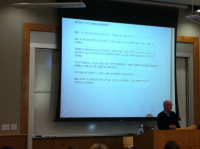
Jennifer L. v. Eighth Jud. Dist. Ct. (Nev. Supreme Ct. – June 4, 2015)
The issue is whether a parent can be held responsible for neglecting a child when a legal guardianship is in place over the child.
Jennifer is civilly committed and resides in Wisconsin under a doctor’s care. She has been diagnosed with schizoaffective disorder. A court order requires that Jennifer take her prescribed medication and see a caseworker.
R.L. is Jennifer’s daughter. R.L. was residing in Nevada with her father, David, and his wife, Evelyn, at the time of David’s death in 2009. Evelyn cared for R.L. for a short time after David’s death and was appointed R.L.’s guardian in December 2009. However, in May 2010, Evelyn terminated her guardianship and Evelyn’s neighbor, Marjorie, became R.L.’s legal guardian. Thereafter, Marjorie moved to California and left R.L. under the care of Brenda. Although school documents identified Brenda as R.L.’s guardian, Brenda’s guardianship was never legitimately established pursuant to NRS Chapter 159.
While R.L. was residing with Brenda, she accused Brenda of battering her, encouraging her to sell marijuana, threatening to kill her if she called Child Protective Services, and spending her social security checks without providing for her basic needs. After R.L. resided with Brenda for three years, the Department of Family Services (DFS) removed R.L. The allegations against Brenda were unsubstantiated, but Brenda no longer wanted R.L. living in her home.
Subsequently, the State filed an abuse and neglect petition naming R.L. as a minor in need of protection pursuant to NRS Chapter 432B and asking the court to declare R.L. a ward of the court. The petition identified Jennifer and Marjorie as R.L.’s mother and legal guardian, respectively, and alleged that Jennifer’s mental health issues adversely affected her ability to care for R.L. Marjorie was eventually removed from the petition, leaving Jennifer as the sole responsible party.
Jennifer entered a denial in response to the petition. She also filed a motion to dismiss the petition, arguing that no material facts were at issue because she had neither legal nor physical custody of R.L. and therefore could not be responsible for neglect.
On October 31, 2012, an order of reasonable efforts was issued by the hearing master. The hearing master found that DFS made reasonable efforts pursuant to NRS Chapter 432B to prevent removal, including discussion with Jennifer about placing R.L. in her home. The hearing master further found that allowing R.L. to reside with Jennifer was contradictory to R.L.’s welfare.
On February 20, 2013, the hearing master issued a decision sustaining the allegations in the abuse and neglect petition and finding that Jennifer’s anxiety and depression affected her ability to provide care for R.L. Among other findings, the hearing master found specifically that (1) Jennifer was receiving intensive in-home care; (2) Jennifer had a co-occurring diagnosis of schizoaffective disorder with delusions and alcohol dependence; (3) Jennifer had severe memory impairment, for which she was required by court order to take medication; and (4) when R.L. last visited Jennifer, R.L. took on the parent role. The hearing master found that it was in R.L.’s best interest to be adjudicated a child in need of protection pursuant to NRS 432B.330 and recommended that R.L. remain in the custody and control of DFS. The juvenile division of the district court adopted the hearing master’s recommendation, finding Jennifer responsible for neglect because her mental condition prevented her from providing care for R.L. Jennifer’s request to stay the proceedings pending a writ petition to the Nevada Supreme Court was denied by the juvenile division of the district court.
Pursuant to NRAP 3A(b)(7), Jennifer cannot substantially appeal from the juvenile division of the district court’s abuse and neglect determination. Since Jennifer’s petition raised the important legal question of whether a parent may be responsible for abuse or neglect when parental rights have not been relinquished and a guardianship over the child pursuant to NRS Chapter 159 is in place, the Nevada Supreme Court exercised its discretion and considered the petition.
Jennifer argued that she cannot be responsible for neglect because Marjorie was R.L.’s guardian when the petition was filed. The State contended that NRS 159.079, the statute under which Marjorie’s guardianship was established, did not relieve a parent from the duty to provide for the care, support, or maintenance of a child. The juvenile court concluded that a guardianship need not be set aside for parental responsibility to exist.
Despite NRS 159.079’s plain meaning, Jennifer contended that her case was similar to Chapman v. Chapman, 96 Nev. 290, 294, 607 P.2d 1141, 1144 (1980), where the Nevada Supreme Court determined that a parent could not be responsible for neglect when the child was left with someone known to be providing proper care for the child. According to Jennifer, R.L. had been receiving proper care from Brenda, and there was no dispute over that fact. However, the Court noted that fact is disputed by both the State and the juvenile division of the district court; the facts established that Brenda was no longer willing or able to care for R.L. Thus, the juvenile court concluded that Chapman was inapplicable. The Court also determined that the rule announced in Chapman did not apply to this case.
The Court explained it may be true that R.L. was initially being properly cared for by her stepmother Evelyn and then by Marjorie. However, those circumstances changed when R.L. was residing with Brenda and reports of alleged abuse and neglect surfaced. Although the reports against Brenda were unsubstantiated, Brenda was no longer willing to provide care for R.L. Moreover, Jennifer was unable to provide care for R.L. due to her mental illness. Thus, at the time of the petition, R.L. was not receiving proper care, making this case distinguishable from Chapman.
Because Chapman is inapposite and NRS 159.079(7) explicitly preserves parental responsibility for a child, even when a guardianship is in place, the Court concluded that the juvenile court properly sustained the neglect petition based on Jennifer’s inability to provide proper care for R.L.









